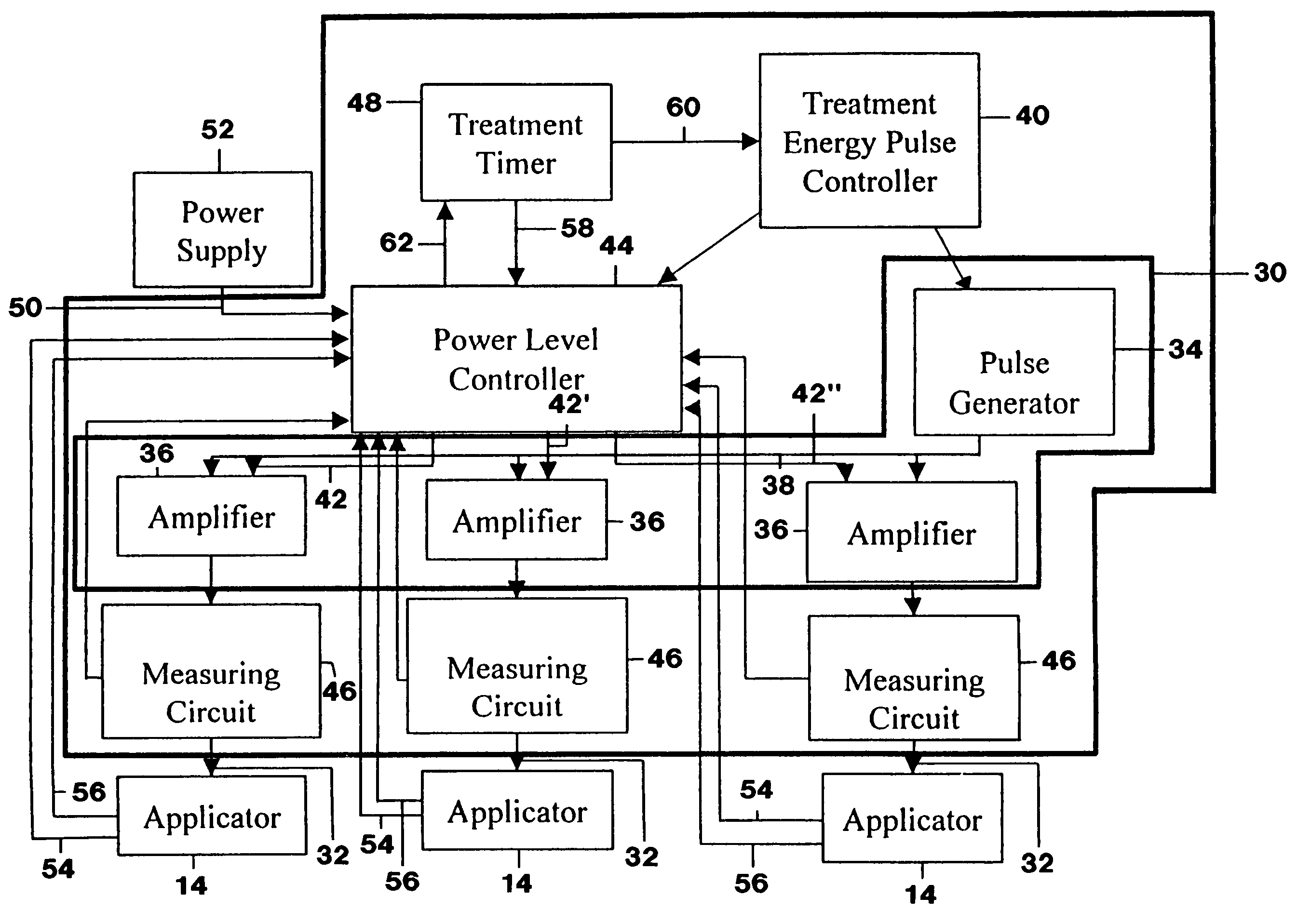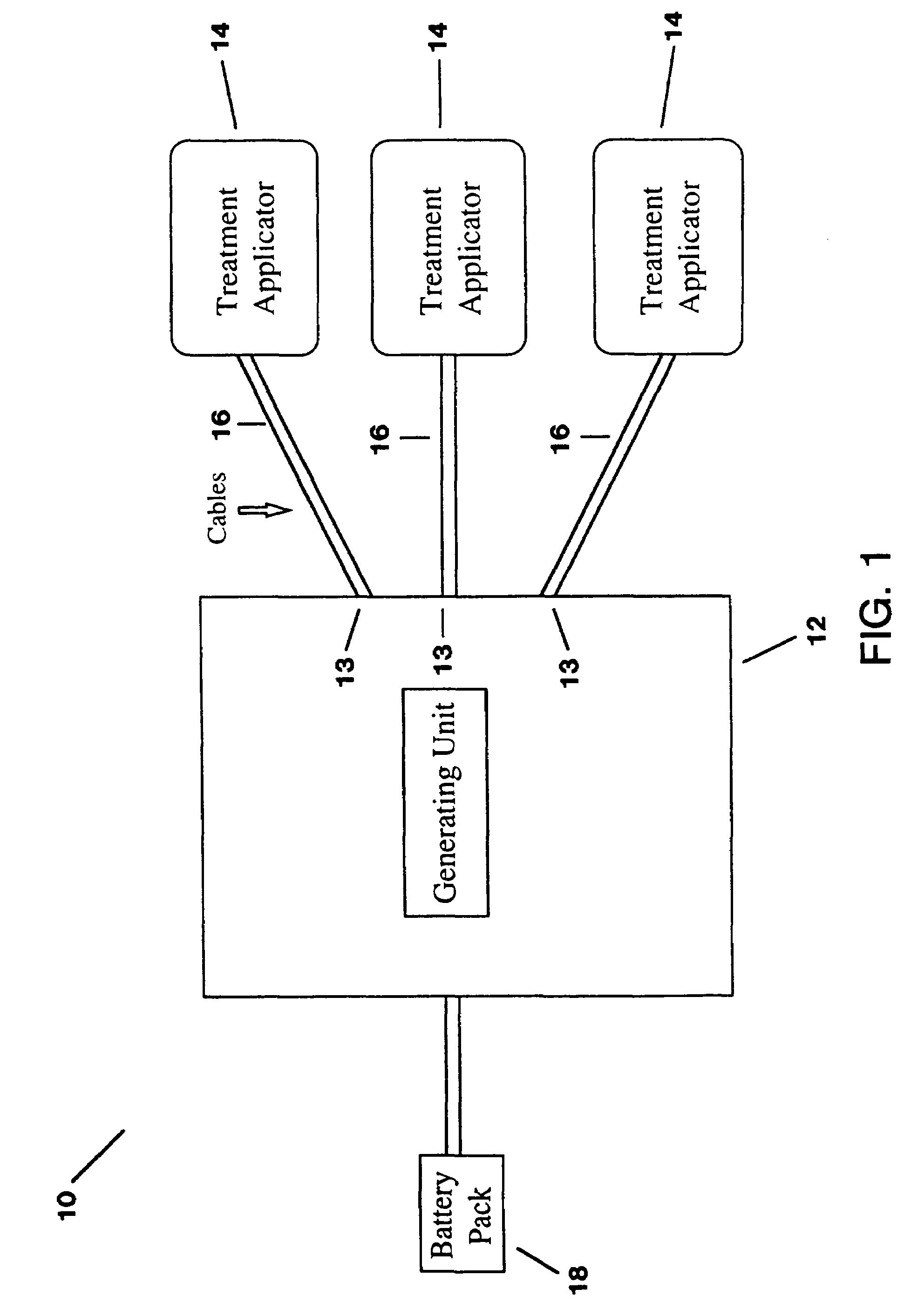Pulsed electromagnetic energy treatment apparatus and method
a technology of electromagnetic energy and treatment apparatus, which is applied in the field of electromechanical devices and methods for therapeutically treating human body tissue, can solve the problems of lack of therapeutic efficacy, and current pharmaceutical approaches that do not fully mimic the spatial and temporal patterns of growth factor activity needed, so as to reduce the size, bulk and power requirements, and simplify the treatment method.
- Summary
- Abstract
- Description
- Claims
- Application Information
AI Technical Summary
Benefits of technology
Problems solved by technology
Method used
Image
Examples
example 1
[0100]This example describes treatment on fibroblasts, a cell type critical to the wound healing process, using the present invention. Immortalized (Rat-2) or primary (human SA-1) fibroblasts were plated 24 hours prior to treatment in 96-well trays at initial densities from 500–10,000 cells per well in Dulbecco's modified Eagle's medium supplemented with high (10% horse, 5% fetal calf) or low (0,5% fetal calf) serum. Cells were treated either with the present invention or a control. The treatment parameters for the present invention, i.e., pulse duration, peak power, average power (dose) and rate of pulse presentation, were systematically varied. Optimal average power, pulse duration and repetition rate were shown to be about 32 mw / cm2, about 32 μs, and a mean of about 1,000 pps respectively. Systematic changes in proliferative response as a function of changes in parameter value were found for all conditions. These results demonstrate that specific characteristics of the present in...
example 2
[0101]This example evidences the dose- and time-dependent effects of treatment using the present invention on Rat-2 immortalized and SA-1 human primary fibroblasts in culture. Cells plated in multi-well trays at a series of densities in medium supplemented with serum at different concentrations were treated using the present invention at an average dose of between about 0–178 mw / cm2. Other cells were treated with 32 mw / cm2 for 0 to 60 minutes. After 24 hrs, cells were quantitated directly, via mitochondrial enzyme activity or crystal violet staining. When control logic circuits were preset to provide a pulse width of 32 microseconds and a pulse rate of about 600–1,000 pulses per second, proliferation was significantly enhanced (50–200%, p50 of 15 mw / cm2and an ED99 of 32 mw / cm2. Maximal proliferation occurred following 15–60 min treatment time with ½-maximal effects at 8 min. These results reveal optimal and minimal doses and times of treatment to trigger proliferation response.
example 3
[0102]Example 3 describes a novel and proprietary method of accelerating healing to closure of chronic cutaneous wounds. It is clear that effects seen clinically and in vitro are based upon enhanced pro-proliferative effects. Evidence for a specific mechanism for enhanced cell proliferation has now been obtained. Rat-2 immortalized or SA-1 human primary fibroblasts seeded at initial densities from 500–10,000 cells per well were treated with a 32 mw / cm2 dose or sham treated (naive). At times ranging from 0 to 16 hr posttreatment, medium was removed from wells containing treated cells and transferred to wells containing naive cells. To define positive and negative controls, respectively, some treated cells were kept in medium throughout, and some naive cells were not exposed to treated medium. At 24 hr posttreatment, all cells were crystal violet stained and quantified spectrophotometrically. Modest proliferation above control levels was observed for cells treated with the present inv...
PUM
 Login to View More
Login to View More Abstract
Description
Claims
Application Information
 Login to View More
Login to View More - R&D
- Intellectual Property
- Life Sciences
- Materials
- Tech Scout
- Unparalleled Data Quality
- Higher Quality Content
- 60% Fewer Hallucinations
Browse by: Latest US Patents, China's latest patents, Technical Efficacy Thesaurus, Application Domain, Technology Topic, Popular Technical Reports.
© 2025 PatSnap. All rights reserved.Legal|Privacy policy|Modern Slavery Act Transparency Statement|Sitemap|About US| Contact US: help@patsnap.com



